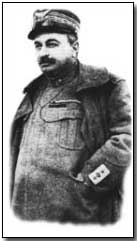Battles - The Eleventh Battle of the Isonzo, 1917
 Launched on 19 August 1917 the Eleventh Battle of the Isonzo was the final initiative
along the Isonzo River to be launched by the Italians and their Chief of
Staff
Luigi Cadorna.
Launched on 19 August 1917 the Eleventh Battle of the Isonzo was the final initiative
along the Isonzo River to be launched by the Italians and their Chief of
Staff
Luigi Cadorna.
For a single-article background to the Isonzo battles click here.
Cadorna's eleventh attempt at breaking the deadlock along the Isonzo and so finally putting an end to the ongoing war of attrition saw him gather together 51 divisions and 5,200 guns. The target was, once again, to be the Carso and around the Italian bridgehead at Gorizia.
Having opened on the coastal zone Italian gains (under Duke Aosta's Third Army) were achieved as the Austro-Hungarian line was inexorably pushed back. In the north gains were particularly marked with some 10km of ground snatched from the Austro-Hungarians by Luigi Capello's Second Army.
Indeed the Italian advance was so successful (capturing the Bainsizza Plateau south-east of Tolmino) that the army outran its artillery and supply lines, thus preventing the further advance that may have finally succeeded in breaking the Austro-Hungarian army. However the Austro-Hungarian line ultimately held and the attack was abandoned on 12 September 1917.
No further attempts were made by the Italians along the Isonzo. All eleven Isonzo battles to date had been initiated by Cadorna; however a twelfth and final battle took place a month-and-a-half later. Cadorna, aware that the Germans were planning a joint offensive with the Austro-Hungarians ordered Capello's forces to withdraw his forward units to more readily defensible positions. Capello's decision to ignore Cadorna's orders (buoyed by his own recent success) contributed to the Italian disaster the following month.
In late October Austria-Hungary's ally, Germany, finally committed forces to a joint operation at Caporetto. While the Austro-Hungarians had often pleaded for German assistance on the Italian Front it was only now granted with the recognition that the Austro-Hungarian army had finally been stretched to breaking point, with the consequent - and very real - possibility that the Italians would soon achieve their long-sought breakthrough. Fortunately with hostilities on the Eastern Front ceasing along with Russia's withdrawal from the war, German resources could be (and were) transferred to the Isonzo.
Often referred to as the Battle of Caporetto, the Twelfth Battle of the Isonzo was a spectacular success for the Central Powers and very nearly succeeded in knocking Italy out of the war.
Click here to view a map charting the progress of the first eleven battles of the Isonzo.
Click here to read U.S. Ambassador to Italy Thomas Nelson Page's summary of the battle; click here to read the view of the head of the British Red Cross effort in Italy, G.M. Trevelyan.
Photograph courtesy of Photos of the Great War website
A "biff" was a Bristol fighter plane.
- Did you know?
